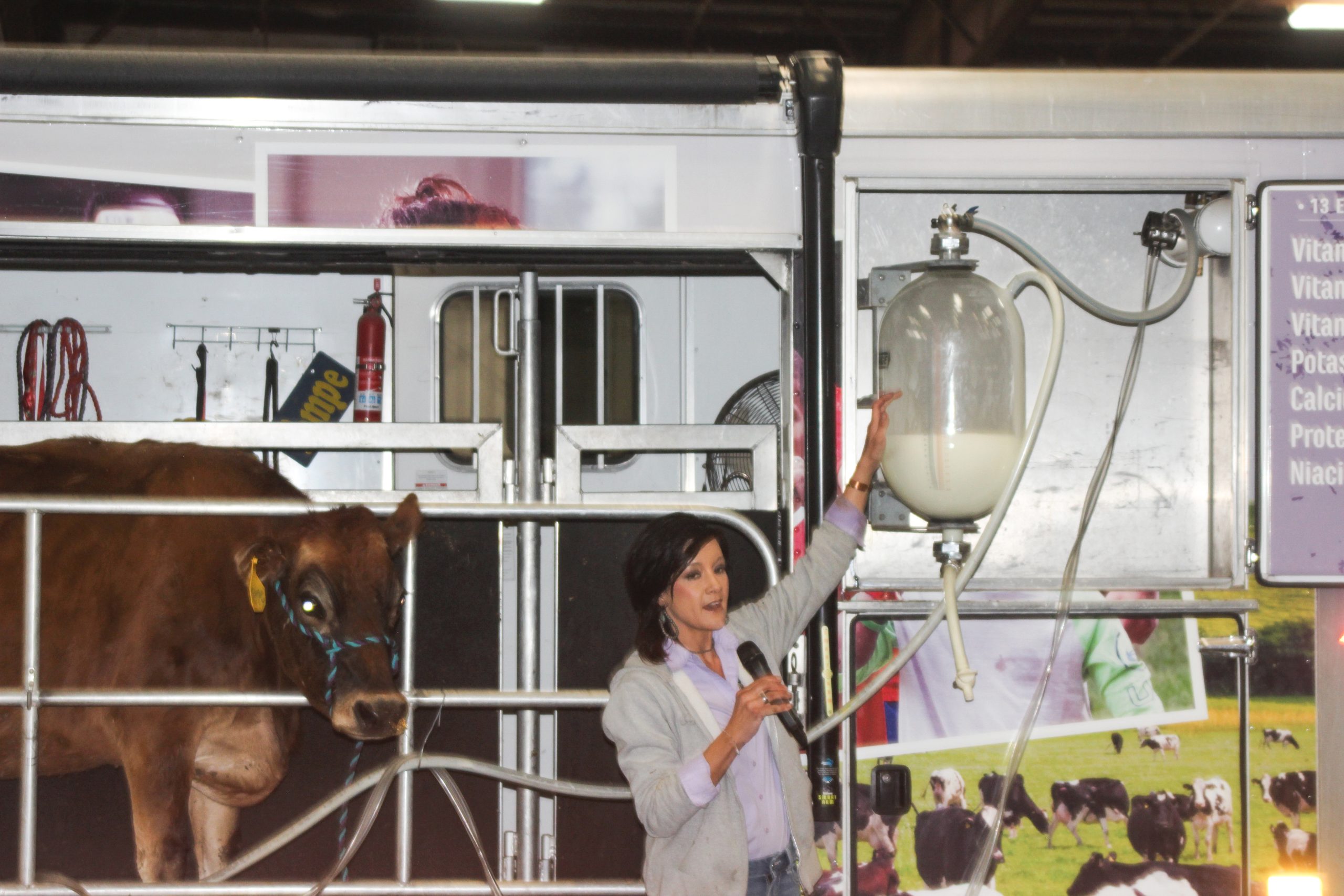Got milk! Mobile classroom tells a dairy story

Milk took center stage during the recent 3i SHOW, where children and observers could learn about dairy production and nutrition.
Kari Hamilton, an instructor with the Mobile Dairy Classroom, a program offered by the Sulphur Springs, Texas-based Southwest Dairy Farmers, taught attendees about the quality of dairy products.
“Milk is for everyone of all ages,” she said.
In the above photograph, Instructor Kari Hamilton with Tempe, a 5-year-old Jersey, describes the importance of milk in a child’s diet. Hamilton and Tempe were at the recent 3i SHOW in Dodge City, Kansas, as an educational program. (Journal photo by Dave Bergmeier.)
Unmatched nutritional value
The nutritional value of milk products, she said, is unmatched. A glass of cow’s milk has 13 essential vitamins and minerals, and she tells children that helps build strong muscles, healthy bones and shiny teeth.
Teachers tell Hamilton that they are impressed with an 8-ounce glass of milk. The U.S. Department of Agriculture’s MyPlate recommends children have about 2 1/2 to 3 cups of milk a day, and one cup is equivalent to 8 ounces. The most prominent vitamins and minerals in milk are calcium, phosphorus, potassium, riboflavin and vitamins B-12, A and D.
“Dairy products are absolutely nutritious in milk and cheese,” she said.
Hamilton is an instructor who travels to schools and other settings. She is from Spring Hill, Kansas, which is near Kansas City.
Hamilton is a natural fit because she once taught school before accepting a position in 2019 with the Southwest Dairy Farms. Children are inquisitive, and she enjoys the interaction with them. The dairy story reaches beyond children.
“Even in Kansas City, people don’t know where milk comes from or how it gets to their kitchen table,” she said.
Drawing a connection helps to bridge the knowledge gap.
Hamilton’s ag background
Hamilton and her husband also have a hay and cattle operation, so transitioning from a traditional classroom to a mobile one is something she relishes. She also has several other dairy cows that are part of the mix.
“This is my career,” she said.
“My coworker is a cow,” Hamilton quips.
She easily handles the star of the show—Tempe, a 5-year-old Jersey that weighs 850 pounds—who is good-natured and comfortable before crowds. For safety reasons, Hamilton cannot let the children pet Tempe, but she can tell there is a positive connection.
“I love to take her out of her stall and see the reaction from the kids, and I hear so many good comments from teachers,” Hamilton said.
Tempe produces about 35 pounds of milk a day.
Sign up for HPJ Insights
Our weekly newsletter delivers the latest news straight to your inbox including breaking news, our exclusive columns and much more.
When she tells them the Jersey breed has a reputation for rich milk that is ideal for making ice cream, they smile. She tells them there are several breeds and that Holsteins produce the most milk.
Dairy industry support
The mobile classroom is free because dairy farmers pay for the service, and they believe that outreach helps to tell their story. From Hamilton’s own experience, she knows that schools face tight budgets. At one time teachers regularly scheduled field trips, but often those are the expenses eliminated.
In rural areas, field trips allowed children to see an operational dairy farm or a milk processing plant.
Dairy farmers continue to see the value, as do teachers and administrators, she said. A fleet of mobile classrooms are deployed to keep the dairy industry top of mind.
“This is a field trip that comes to you,” Hamilton said, adding that state fairs and community events are a popular place to see the mobile classrooms.
A truck pulled a trailer that doubled as parlor with displays adorning the side. Tempe was able to feed in a corral set up at the Western State Bank Expo Center in Dodge City, Kansas.
Hamilton’s presentation lasted about 30 minutes. She explains to children how dairy farmers use antiseptic medicine to treat the teats before attaching a device to collect the milk. In Tempe’s case a milk “claw” is gently placed on her teats, and she relaxes while her milk is collected.
As Hamilton goes through the process, children can watch the milk travel to a clear container. The milk cannot be consumed because it has not been treated through a pasteurization and homogenization process to ensure safety, Hamilton explains.
She tells the students that on a farm milk needs to be quickly processed because it is destined to be in the grocery in 48 hours.
In some settings, Hamilton said she will provide ice cream sandwiches, which is a big hit with the children. “The kids love that, and at the same time they can see where it all starts.”
Milk is available
During Hamilton’s presentation, she reminds students that milk is available for school breakfasts and lunches and then smiles to tell them that chocolate milk is also good for them. Milk itself does not have added sugar, which is another reason to promote the product.
“It’s all natural and the best thing for their bodies, and it can benefit their immune system,” she said.
What led Hamilton and Tempe to the 3i SHOW was that Eddie Estes, president and CEO of the Western Kansas Manufacturers Association, was wanting an education program, and with the addition of Hilmar Cheese and a growing dairy industry in the High Plains region, he thought it would be a good fit. Hamilton agreed and stayed March 12 to 14.
For more information on the mobile classroom, visit southwestdairyfarmers.com.
Dave Bergmeier can be reached at 620-227-1822 or [email protected].


